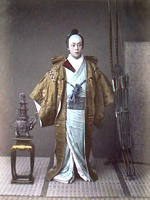photo
Early photography in Japan
Foreign photographers immediately began to come to the treaty ports, with American Orrin E. Freeman being the first to set up a studio in Yokohama in 1859. Other early visitors included the Englishman William Saunders who spent 3 months in Yokohama in 1862. A French photographer, P Rossier, lived for some time in Nagasaki in 1859-60 and taught the wet-plate process to several Japanese, including Hikoma Ueno. Iosef Antonovich Goshikevitch(18xx-75), the first Russian consul in Hakodate in 1858, was also a photographer and taught several Japanese photographers. Little seems to be known about the work of these photographers.
Felice Beato (c1825-c1908) came to the Far East in 1860, and was the first Western photographer to work in China, following the British armies during the Second Opium War. Beato had earlier been assistant to James Robertson, whose work in the Crimea was probably the first war photography, and had also travelled with Robertson around the Mediterranean and Middle East.
Beato was probably born in Venice, but at some point he and his brother, Antonio (or Antoine) Beato (c1830-c1903), both became British citizens. This was a period when the UK welcomed political exiles and many Italian nationalists were living and working in London, as well as others who came for economic reasons.

Antonio Beato was also a photographer and at times the two brothers had worked together and signed some pictures Felice Antonio Beato. For many years, photo historians thought the two brothers to be a single person, creating some problems with pictures on similar dates taken on different sides of the world. Antonio stayed mainly in Egypt, running a flourishing business taking pictures of the antiquities there.
Beato arrived in Japan in 1862/3 and lived in Yokohama from 1863 until 1884. For some years, Japanese prints, with their delicate colouring had been very popular in Europe. For several years, Beato worked in partnership with the watercolorist, Charles Wirgman, who was able to add washes of colour to his albumen prints of views of Japan, especially Yokohama, and pictures of 'Native Types'.

